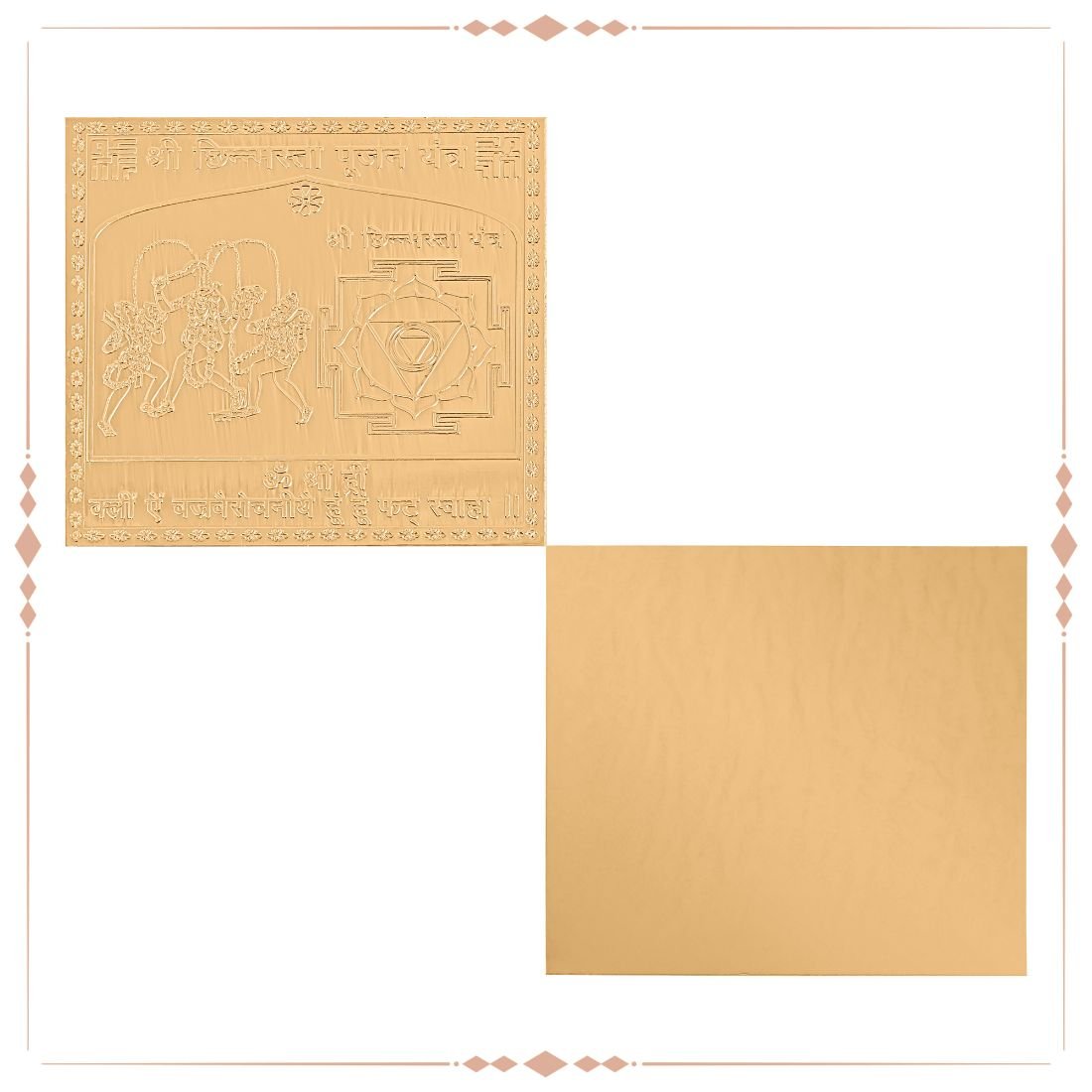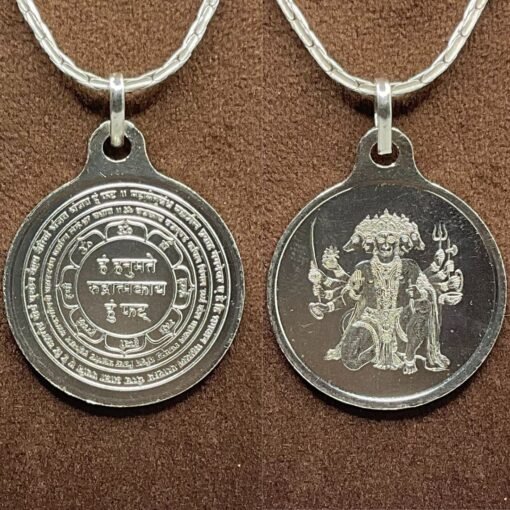Currency
Shri Chhinmasta Yantra Gold Plated – 3 inches
- Auspiciously made from the Vedic Diagrams.
- The Yantra will be Blessed and Energised before dispatch
- Yantras are premium quality and heavy guage.
₹350 – ₹2,710

Get 3% Discount on Prepaid Orders
Shri Chhinmasta Pujan Yantra
Shri Chhinmasta Pujan Yantra is a sacred and powerful geometric design associated with the goddess Chhinmasta, one of the ten Mahavidyas in Hinduism. She is known as the goddess of self-sacrifice, inner awakening, and the destruction of ego. The Chhinmasta Yantra is a spiritual tool used to invoke the goddess’s blessings and to remove obstacles, fulfill desires, and bring success in various aspects of life.
The Shri Chhinmasta Pujan Yantra is a revered and powerful geometric representation that serves as a focus for the worship and invocation of Goddess Chhinmasta, one of the ten Mahavidyas in Hinduism. Goddess Chhinmasta is often depicted as a fierce, self-decapitated deity who symbolizes the transcendence of ego, destruction of negativity, and the power of self-sacrifice for spiritual enlightenment. Her iconography, though intense, represents liberation from worldly attachments and the rise of inner power.
The Yantra (a mystical diagram) dedicated to Goddess Chhinmasta is an intricate design, typically drawn or embossed on various materials such as metal, wood, or paper, and is used during puja (ritual worship) for invoking her blessings. It is said that through the proper worship of this Yantra, devotees can gain spiritual awakening, protection from evil forces, and enhanced inner strength.
Benefits Of Shri Chhinmasta Pujan Yantra :
The Shri Chhinmasta Pujan Yantra is a sacred and powerful tool used for spiritual worship, particularly in the context of Hindu rituals. It is associated with Goddess Chhinmasta, one of the ten Mahavidyas, known for her fierce and transformative qualities. The Yantra is believed to have several benefits, especially for individuals seeking personal growth, protection, and spiritual advancement. Below are the key benefits associated with the Shri Chhinmasta Pujan Yantra:
1. Spiritual Awakening and Transformation
- Chhinmasta is known as the Goddess of transformation. Worshiping the Yantra is said to awaken dormant spiritual powers, leading to a deeper understanding of the self and the universe. It helps the devotee break free from the illusions of the material world and move toward a higher state of consciousness.
2. Protection from Negative Energies
- The Yantra is believed to protect the worshiper from negative influences, evil spirits, and harmful energies. It is said to create a shield of divine energy around the individual, guarding them from spiritual and physical harm.
3. Removal of Obstacles and Challenges
- Chhinmasta symbolizes the cutting away of attachments and obstacles that impede personal growth. The Yantra is thought to help remove blockages in one’s life, whether they are material, mental, or emotional. It can aid in overcoming difficulties related to health, finances, relationships, and career.
4. Purification of the Mind
- Regular worship of the Shri Chhinmasta Pujan Yantra helps in purifying the mind and cleansing negative thought patterns. It encourages mental clarity, focus, and positive thinking. This can result in increased wisdom and enhanced decision-making.
5. Fulfilling Desires and Attaining Goals
- Devotees believe that worshiping this Yantra helps fulfill their desires and achieve success in personal and professional endeavors. It is considered a powerful tool for manifesting one’s goals and aspirations, particularly for those seeking success, fame, or prosperity.
6. Emotional Healing and Balance
- Goddess Chhinmasta is known to bring balance, even in chaotic situations. The Yantra can help individuals restore emotional stability, reduce stress, and promote inner peace. It supports the release of pent-up emotions and encourages emotional healing.
7. Boosting Self-Confidence and Courage
- As Chhinmasta is a fierce and fearless deity, worshiping the Yantra is believed to instill qualities of courage, strength, and self-confidence. It helps devotees overcome fears and face life’s challenges with determination and boldness.
8. Accelerating Spiritual Growth
- This Yantra is particularly beneficial for those on a spiritual path. It accelerates spiritual practices and helps in advancing toward higher states of meditation and enlightenment. It fosters deep devotion, enhances intuition, and supports progress in mystical or occult practices.
Shri Chhinmasta Pujan Yantra Benefits In Hindi / ( श्री छिन्मस्ता पूजन यंत्र लाभ हिंदी में)
श्री छिन्नमस्ता पूजन यंत्र एक पवित्र और शक्तिशाली साधन है, जिसका उपयोग विशेष रूप से हिंदू पूजा-पाठ और तंत्र साधना में किया जाता है। यह यंत्र देवी छिन्नमस्ता से जुड़ा हुआ है, जो दस महाविद्याओं में से एक हैं और अपनी प्रचंड और परिवर्तनकारी शक्तियों के लिए प्रसिद्ध हैं। इस यंत्र के कई लाभ माने जाते हैं, विशेष रूप से उन व्यक्तियों के लिए जो आत्मिक उन्नति, सुरक्षा और व्यक्तिगत विकास की कामना करते हैं। नीचे श्री छिन्नमस्ता पूजन यंत्र से जुड़ी कुछ प्रमुख विशेषताएँ और लाभ दिए गए हैं:
1. आध्यात्मिक जागरण और परिवर्तन
देवी छिन्नमस्ता परिवर्तन की देवी मानी जाती हैं। इस यंत्र की पूजा से अव्यक्त आत्मिक शक्तियाँ जागृत होती हैं, जिससे व्यक्ति को अपने अस्तित्व और ब्रह्मांड की गहरी समझ प्राप्त होती है। यह यंत्र भौतिक संसार की भ्रांतियों से मुक्ति दिलाकर उच्चतर मानसिक और आध्यात्मिक चेतना की ओर अग्रसर करता है।
2. नकारात्मक ऊर्जा से सुरक्षा
इस यंत्र के बारे में माना जाता है कि यह पूजा करने वाले को नकारात्मक प्रभावों, बुरी आत्माओं और हानिकारक ऊर्जा से सुरक्षा प्रदान करता है। यह यंत्र एक दिव्य ऊर्जा की ढाल बना देता है, जो व्यक्ति को शारीरिक और मानसिक हानि से बचाती है।
3. विघ्नों और चुनौतियों का निवारण
छिन्नमस्ता देवी का स्वरूप उन अड़चनों और बंधनों को काटने का है जो व्यक्ति की प्रगति में रुकावट डालते हैं। इस यंत्र की पूजा से जीवन के किसी भी क्षेत्र में (स्वास्थ्य, वित्त, रिश्ते, करियर) आ रही अड़चनों को दूर किया जा सकता है।
4. मनोबल और मानसिक शुद्धता
इस यंत्र की नियमित पूजा से मन की शुद्धि होती है और नकारात्मक विचारधाराएँ समाप्त होती हैं। यह मानसिक स्पष्टता, ध्यान केंद्रित करने की क्षमता और सकारात्मक सोच को बढ़ावा देता है, जिससे व्यक्ति की निर्णय क्षमता और बुद्धिमत्ता में वृद्धि होती है।
5. इच्छाएँ पूरी करना और लक्ष्यों की प्राप्ति
श्रद्धालु मानते हैं कि इस यंत्र की पूजा से उनकी इच्छाएँ पूरी होती हैं और वे अपने व्यक्तिगत तथा व्यवसायिक उद्देश्यों में सफलता प्राप्त करते हैं। यह यंत्र विशेष रूप से उन लोगों के लिए शक्तिशाली माना जाता है जो समृद्धि, ख्याति और सफलता की प्राप्ति के लिए प्रार्थना कर रहे हैं।
6. भावनात्मक उपचार और संतुलन
देवी छिन्नमस्ता अपने उग्र रूप के बावजूद आंतरिक संतुलन और मानसिक शांति की प्रतीक हैं। यह यंत्र व्यक्ति को भावनात्मक संतुलन बनाए रखने, तनाव को कम करने और आंतरिक शांति की स्थिति में पहुँचने में सहायता करता है। यह अव्यक्त भावनाओं को मुक्त करने और भावनात्मक उपचार को बढ़ावा देता है।
7. आत्मविश्वास और साहस में वृद्धि
छिन्नमस्ता देवी एक निर्भीक और साहसी देवी मानी जाती हैं। इस यंत्र की पूजा करने से व्यक्ति में आत्मविश्वास, साहस और ताकत का संचार होता है। यह यंत्र व्यक्ति को अपने डर को पार करने और जीवन की कठिनाइयों का सामना साहस के साथ करने की शक्ति प्रदान करता है।
8. आध्यात्मिक उन्नति में तेज़ी
यह यंत्र विशेष रूप से उन लोगों के लिए लाभकारी है जो आध्यात्मिक पथ पर चल रहे हैं। यह साधना को तेज़ करता है और व्यक्ति को उच्चतम ध्यान, साधना और आत्मज्ञान की ओर अग्रसर करता है। यह यंत्र गहरी भक्ति, सृजनात्मकता, और अंतर्ज्ञान को बढ़ावा देता है, जिससे व्यक्ति की आध्यात्मिक प्रगति में तेजी आती है।
How To Worship Shri Chhinmasta Pujan Yantra / ( श्री छिन्मस्ता पूजन यंत्र की पूजा कैसे करें)
Worshiping Shri Chhinmasta through the Pujan Yantra involves following a set of ritualistic steps and practices to honor her divine presence and seek her blessings for spiritual growth, protection, and material prosperity. Chhinmasta is a powerful deity in Hinduism, symbolizing the severing of worldly attachments, transformation, and liberation. The Yantra associated with her is considered a potent tool to invoke her divine energy.
1. Preparation for the Worship
Before beginning the worship, it is important to purify both the body and the space. You can do this through:
- Bathing: Take a bath to purify yourself.
- Clean the Puja Area: Ensure the space where you will perform the worship is clean and free of any distractions.
- Items Needed:
- Shri Chhinmasta Yantra
- Red cloth or yellow cloth (to place the Yantra on)
- Fresh flowers (preferably red, yellow, or white)
- Incense sticks (sandalwood or any pure fragrance)
- Ghee (clarified butter) lamp (diya)
- Fresh fruits, sweets (especially offerings like jaggery, coconut, and honey)
- A bell (optional)
- A small vessel of water (for Abhishekam)
- Fresh vermilion (sindoor) and turmeric powder (for tilak)
- A picture or idol of Goddess Chhinmasta (optional but recommended)
2. Setting Up the Pujan Area
- Place a clean, red or yellow cloth on the puja platform or table.
- Lay the Shri Chhinmasta Yantra on top of the cloth.
- If you are using an idol or image of the Goddess, place it near the Yantra.
3. Invocation (Prarthana)
- Start by sitting in a comfortable posture, either on a mat or in a chair, facing east or north (the preferred directions for worship).
- Begin by chanting “Om Shri Chhinmastaye Namah” to invoke the presence of the Goddess.
- Light the incense sticks and the ghee lamp to purify the space and invite positive energy.
4. Offer Water and Cleanse the Yantra
- Gently sprinkle a little water over the Yantra to cleanse it and purify the space. This can be done with your right hand, and you can chant mantras such as “Om Ganga Yamuna Saraswati Namah” while performing this action.
- Wipe the Yantra clean with a cloth if needed.
5. Offer Flowers and Fruits
- Offer flowers, especially red and yellow flowers, as a symbol of devotion.
- Present the fruits and sweets in front of the Yantra as offerings to Goddess Chhinmasta.
6. Chant Mantras
The following are the key mantras you can chant during the worship:
- Chhinmasta Mantra:
- “ॐ श्री च्छिन्नमस्तायै नम:”This mantra is a direct invocation to Goddess Chhinmasta and is used to seek her blessings for removing obstacles and attaining spiritual growth.
- Chhinmasta Gayatri Mantra:“ॐ च्छिन्नमस्तायै विद्महे, कालरात्र्यै धीमहि। तन्नो देवी: प्रचोदयात्॥”
This is a Gayatri mantra invoking the wisdom and power of Goddess Chhinmasta. Chant it 108 times using a mala (prayer beads) for best results.
- Chhinmasta Ashtakshara Mantra:“ॐ ह्लीं च्छिन्नमस्तायै नम:”
The Ashtakshara mantra is another potent chant that helps connect deeply with the Goddess.
7. Offer Vermilion and Turmeric
- Apply a small amount of vermilion (sindoor) or turmeric powder on the Yantra or the idol/image of Goddess Chhinmasta as a mark of respect and devotion.
8. Perform Arati (Optional)
- If you wish, you can perform Arati by waving the ghee lamp or diyas in front of the Yantra while chanting a prayer or the mantras.
- The bell can be rung during the Arati to increase the vibration and energy of the space.
| Weight | 0.100 kg |
|---|---|
| Dimensions | 12 × 15 × 4 cm |
| Select Size | 3" X 3" Copper, 3" X 3" Golden Plated, 6" X 6" Copper, 6" X 6" Golden Plated, 6" X 6" Golden Plated with Frame, 6" X 6" Copper with Frame, 9" X 9" Copper |
Q & A







































